Waiting for the W
By M. J. Tannenbaum
 When I was a sophomore at Columbia
College, my physics teacher (Polykarp
Kusch) had just won the Nobel Prize. In my senior year, another
teacher (T.D.Lee) had also just won the Nobel Prize. I thought
this was normal.
When I was a sophomore at Columbia
College, my physics teacher (Polykarp
Kusch) had just won the Nobel Prize. In my senior year, another
teacher (T.D.Lee) had also just won the Nobel Prize. I thought
this was normal.
The next year, 1960, TD and C.N. Yang proposed the intermediate bosons W± as the quanta that transmit the weak interaction [1] and Mel Schwartz proposed to detect them with high energy neutrinos [2]. Mel asked me to be a thesis student on the neutrino experiment at BNL (AGS-28) but I turned him down because there were already 2 thesis students on this experiment. I chose to work with Leon Lederman in his search for the force of muness-"why does the muon weigh heavy?" I guess that one of the reasons I decided to go with Leon instead of with Mel is that I had spent most of the summer of 1960 talking to Leon about this problem when I was a summer student of Satoshi Ozaki working at the Cosmotron. I spent lots of time in the Cosmotron library reading everything there was to know about electron elastic and inelastic scattering, which was really a hot topic at that time. My thesis was experiment AGS-4(!) (Fig. 1), muon proton elastic scattering, which compared the radius of the proton measured with muons to that of Robert Hofstadter's and Bob Wilson's measurements with electrons, to deduce the difference in the radii of electrons and muons probed by hitting a proton. There was no effect [3], the proton form factor measured with both muons and electrons was identical all the way out to Q2=1 GeV2/c2 [25.7 inverse fm2]. (Never did I realize that these units would help me at RHIC).
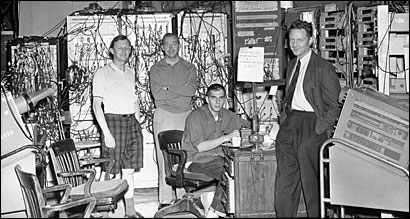
Figure 1: Bosses of μ-p I experiment, c. 1961. (Left to Right) John Tinlot, Rod Cool, Leon Lederman. (Seated) A graduate student.
The results of this measurement were first presented by Leon and John Tinlot (of Rochester) [4] at the 12th International Conference on High Energy Physics which was held in Dubna, Russia in 1964 (a really big deal at the time) so I pored over the proceedings of this conference to see how the result was received. This was the time when questions and discussion as well as the text of the talks were included in the proceedings, and a good question was asked by an A. Zichichi. As I thumbed through the proceedings I found another good comment from Zichichi [5] about how to find the W boson in p+p collisions, which happens to be the way the W was discovered 19 years later. It is so beautiful and concise that I quote it verbatim: "We would observe the μ's from W-decays. By measuring the angular and momentum distribution at large angles of K and π's, we can predict the corresponding μ-spectrum. We then see if the μ's found at large angles agree with or exceed the expected numbers. A supplementary check can be made by measuring the polarization of these μ's. The polarization indicates the origin of these μ's."
After graduate school, I went to CERN as a post-doc in 1965 and worked with Jack Steinberger and Carlo Rubbia on the first K0L−K0s→ π+π− interference experiment [6] following the discovery of CP violation in K0L decay at BNL during my thesis run. I was actually on shift at both the BNL-AGS and the CERN-PS when the motor generators died in both places during that period. The announcement over the loudspeaker at the AGS was something like:"The beam is off, the beam is off, all targets have stopped flipping, all targets have stopped flipping. The beam will be off for approximately 6 months." The 6 month delay in early 1966 at CERN caused by the MG failure resulted in the rescheduling of Jack and Carlo's follow-up K0 "vacuum regeneration" experiment, so I switched over to work on the second muon g-2 experiment, the first one that used a storage ring. I had many discussions with Francis Farley and Emilio Picasso (and Nino Zichichi) in this period on the structure of the proton and on how muons and electrons could be different. I then went to Harvard as an Assistant Prof (eventually Associate Prof) and continued thinking about the "force (or quantum) of μ-ness". One of the reasons that I and others went to Harvard at this time was the Cambridge Electron Accelerator (located close to the museum with the glass flowers on Oxford Street) at which the "Pipkin Effect", the anomalous photo-production of wide angle e+ e− pairs had been discovered in 1965. As Emilio and I got Norman Kroll (another of my Columbia teachers, who was visiting CERN) to write for us in the paper from the g-2 measurement [7], this apparent violation of QED could only be due to a violation of gauge invariance or, as suggested by Francis Low, the production of an excited electron, e*→ e+γ.
Almost as soon as I arrived at Harvard, Leon asked me to collaborate on a review article on Muon Physics that he had been commissioned to write [8]. I got two interesting new ideas in writing this article: the formalism for the design of transversely and longitudinally polarized muon beams (which was actually used by the Spin Muon Collaboration [9]); and the idea to measure the force between muons by scattering muons from each other-the analogy being the strong force which is not visible in muon-proton scattering but knocks you over in p-p scattering. Although a hot-topic at BNL now, colliding beams of muons didn't exist at that time and still don't exist, so I had the idea of using a muon to produce a muon-pair in the field of a nucleus, the muon-trident, μ± + Z→ μ± + Z +μ+ + μ−. Also, since there would be two-identical muons in the final state, this reaction would measure the statistics of the muon-with para-statistics such as the existence of red, green and blue muons [sound familiar?] being a possible explanation of the μ-e difference.
In order to calculate the rates and sensitivities for the proposal to the AGS, I needed the muon-trident cross sections. Stan Brodsky and Sam Ting (both of whom were post-docs I had known while a graduate student at Columbia) had just written a long article on this process as a test of QED [10] but had only shown differential distributions in the 3 independent solid angles and two energies while I needed the integrated cross section. Stan had computed all the effects including the exchange diagrams for identical muons in the final state and kindly sent me his computer code for calculating the matrix elements, which was a full box ( ∼ 2000) of IBM cards. I succeeded [11] in summing, squaring and integrating the matrix elements using a novel Monte Carlo technique which was: "a tricky business because there was no simple analytical expression to use as a guide" and because the matrix elements diverged any time any of the 6 momenta involved became collinear. This exercise started a long-lasting relationship of common interests and friendship between Stan and me, resulting in, among other things, Stan's proposal to use direct-pair production by anti-protons followed by capture of the positron as the first method to make anti-hydrogen [12] soon after my having invited him to BNL in 1990 to a workshop on "Can RHIC be used to test QED" [13] at which he provided the famous 34kb cross section for Au+Au → Au+Au + e+ +e− at √{sNN}=200 GeV (which followed by the capture of the e− by an Au79+ nucleus and its subsequent loss from the beam due to the change in charge is the limitation of the luminosity in Au+Au, or Pb+Pb, colliders).
Coming back to the muon-trident experiment, it was approved and ran for 200.0 hours at the AGS in January-February 1968 with the result of Fermi statistics for the muon and no anomalous muon-muon force [14]. Interestingly, the first preliminary results from this experiment were presented by Pief Panofsky as a rapporteur at the 14th ICHEP in Vienna in 1968 [15] and I was a bit miffed at the time because I thought that he didn't give it enough space compared to the new SLAC result on the "continuum excitation" in inelastic electron scattering, the now famous Deeply Inelastic Scattering. [In retrospect, Pief's talk was really great, and fair to the large number of other results whose significance pales in comparison to the DIS discovery].
The Bjorken scaling, which led to the understanding of the DIS measurement, together with the results of another di-muon experiment at the AGS in this period (the discovery of Drell-Yan muon pairs) led Leon Lederman to propose in the ISABELLE workshop series of 1971-72 that to detect the violation of unitarity of the pure weak interaction p+p→ μ+ νμ +X (if there were no W±), or to detect the W± at ISABELLE (√s=400 GeV), "the luminosity required is > ∼ 5 ×1033 cm−2 s−1. At this luminosity, Isabelle is guaranteed to make at least one fundamental discovery!" You might ask why Leon was looking at di-muons in p+p collisions, which had no relation to muon-muon scattering. Actually Bob Crease covered this nicely in his articles on "The ISABELLE saga" [16]. In brief, Leon and others who were looking for W± production in p+p collisions needed to know the time-like form factor of the proton, which could be measured by di-lepton production, in order to set limits on the W± cross section (and thus mass) from their non-observation of any excess high pT single leptons.
This was also the time of the startup of FERMILAB and I had joined 3 proposals: E70 with Leon to look for the W± in p+p collisions via single (and di-)leptons; E87 with Wonyong Lee to look for W± and heavy leptons in photoproduction (although I knew from my CEA experience that e+ + e− collisions were better if they had sufficient c.m. energy); and E98, muon scattering, with the Harvard group. Also, at this time I moved to the Rockefeller University, where Rod Cool (who had been ALD at BNL and collaborated on my thesis experiment had hired me into his new group) had proposed together with Leon Lederman a W± search for e± produced at 90 degrees to the colliding beams at the new CERN ISR. In the meantime, I collaborated with Leon on another muon experiment at the AGS (μ-p II, Fig. 2)
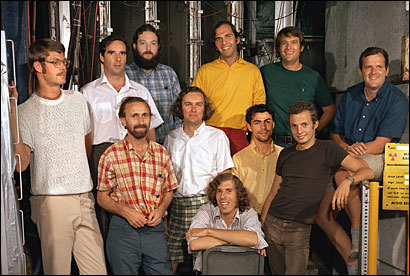
Figure 2: Several Members of μ-p II experiment, c. 1972. (Top Row-Left to Right) Tom Kirk, Mike Murtagh, Morgan May, MJT, Peter Limon, Hans Jostlein (Seated) Howard Gittleson.
at which we made the first measurement of μ-A DIS thinking that if there were really point-like partons inside a proton the DIS cross section in a nucleus should be A times larger (Morgan May's thesis)-we found A1.00 [17]. With two Harvard graduate students, I also looked for excited muons (Howard Gittleson's thesis [18]) and recoil hadrons from DIS (Mike Murtagh's thesis [19]-Mike later became chair of the BNL Physics department) with secret hope that the hadrons would show evidence of Bjorken's point-like partons (they didn't).
The "W" experiment at the ISR got results in 1972, but, instead of finding an excess of high pT leptons perpendicular to the beam, found an excess of high pT pizeroes-the exponential pT spectrum observed in cosmic rays and paramaterized as e−6pT by Cocconi [20] broke off and became a much flatter power-law for pT ≥ 2 GeV/c, thus greatly increasing the background for the W±→ e±+X search. The high pT π0's proved that the partons from DIS interacted strongly with each other which couldn't be derived from the purely electromagnetic electron-proton (actually electron-quark) scattering. [This is the same idea as the search in muon-trident production for a muon-muon force which would not be evident in muon-proton scattering.] The high pT announcement was the hit of the 1972 ICHEP in Chicago [21] and was clearly indicative of exciting new physics, so I resigned from all my FERMILAB experiments and moved to Geneva to be with the Rockefeller group and continue the famous CERN-Columbia-Rockefeller (CCR) series of experiments. We made several other discoveries in this series including direct single e± [22] (the first evidence for open charm, but we didn't know it at the time), direct single-photon [23] and experimental proof using same and away-side two-particle correlations that high pT particles in p-p collisions are produced from states with two roughly back-to-back jets which are the result of scattering of the constituents of the nucleon as described by QCD which was developed during the course of these measurements [24]. Interestingly, but not accidentally [25], these are the same techniques that we proposed and used at PHENIX in the initial search for (and discovery of) the QGP at RHIC since the huge multiplicity in Au+Au collisions gives an enormous combinatoric background which is minimal for single particle measurements and not too bad for two-particle measurements. At the ISR, we also just missed discovering the J/Ψ and Υ, having been beat out by lower energy machines with much higher luminosities even though the ISR had a respectable L=5×1031 cm−2 s−1 (DC) and could run as high as 1.4×1032 with the superconducting low β quads (which had been assigned to another experiment).
It was during this same period that ISABELLE and the CERN collider were being proposed. Several of my European CCR colleagues (Luigi Di Lella and Marcel Banner) started the UA2 experiment but I decided that ISABELLE would be better and took the opportunity to return to BNL in 1980 to help sort out the magnet problems. (Again Bob Crease tells a nice story about this, but if you want to know my opinion of why the ISABELLE braid magnets didn't work at 5 Tesla, come to my office and I'll give you a demo). With the success of the Palmer magnet, I got transferred to the Physics department in 1982 where two miracles happened. While at the magnet division, I had requested to attend the 1982 ICHEP (in Paris, France) and was submitted by BNL as an alternate. The first miracle is that Mark Sakitt, who was one of the official BNL delegates, decided not to go. I understood from Kit D'Ambrosio (who was Rod Cool's secretary when he was ALD and was still the ALD secretary in 1982) that the ALD (Nick Samios) originally didn't want me to be the substitute for Mark but she insisted that since BNL had told the French that I was the alternate, BNL had to send me to avoid an international incident. The second miracle was that Dave Levinthal (at Columbia) and Steve Pordes (at FERMILAB) working on the CCOR data in the two years that I was making magnets had figured out why the pizero-pair data, which I had suggested be analyzed in the same variables (pair-pT, pair-invariant mass, pair-rapidity and angle in the pair c.m. system) that were used in lepton-pair analyses, had too steep a cosθ* dependence. Since this process corresponded to quark-quark elastic scattering in the newfangled QCD, the Q2=−[^t] ≈ m2π0 π0 (1−cosθ*)/2 is reduced for angles forward of 90° (cosθ*=0). This causes the running coupling constant αs(Q2) to increase at more forward angles, which steepens the angular distribution. The incredible thing about this data is that the way we had constructed the π0-π0 cosθ* distribution, it could be directly compared to the parton-parton constituent level scattering cross-section in QCD without need for a Monte Carlo (although of course we did the Monte Carlo and showed that this was true).
I showed these results at the famous Snowmass conference of 1982 [26] that was organized by the DPF to consider the future facilities for particle physics in the U.S. which included proposals for e+ e−, e-p and hadron-hadron colliders and was attended by 150 physicists from all these fields. There was a matrix of physics categories (e.g. specific standard model tests at the different machines) and I headed the QCD-dynamics subgroup, "Isolating and testing the Elementary QCD subprocesses", of the standard model group, with a view, for instance, of testing the recently published formulas for hard scattering of the underlying partonic subprocesses in pQCD, e.g. q+q → q+q, g+q → gamma+q, in analogy to precision tests of QED [27]. However, in the U. S. HEP community gathered at Snowmass, there were doubts about the existence of jets in hadron-hadron collisions [28] caused by an erroneous claim for jets at FERMILAB in 1977 which was contradicted by a result by NA5 (CERN) presented at the 1980 ICHEP which showed that there were no jets in large aperture full azimuth calorimeters triggered on the sum of transverse energy (ET), or in their words, "the large ET observed is the result of a large number of particles with a rather small transverse momentum". Hence, I could not convince the lepton physicists and even had difficulty convincing the hadron physicists of the value of my plot or even of the utility of QCD tests in hadron-hadron collisions since everybody was much more interested in the Electro-Weak side of the standard model, namely discovery of the W±. My main role in the strong BNL effort on this subject (which had been the principal goal for HEP and certainly ISABELLE at this time) was in understanding the background from hard-scattered hadrons.
As I worked on the W±, I became more interested in the parity-violating aspect, which led to my interest in later founding the RHIC spin collaboration along with Gerry Bunce, Yousef Makdisi, Thomas Roser, with encouragement from Satoshi Ozaki, Larry Trueman, Sam Aronson, Tom Kirk and many others.
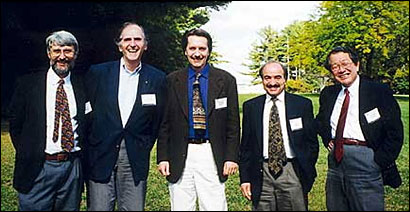
Figure 3: Some founding members of RSC-Bunce, MJT, Roser, Makdisi, Ozaki
My interest in spin was originally piqued by my having attended the 1980 Symposium on High Energy Physics with Polarized Beams and Polarized Targets in Lausanne as (of all things) a representative of FERMILAB since I had designed a coherently hardened photon beam (which was also polarized) to enhance the high energy tail of the brems-spectrum for E87 [29]. Interestingly, in reviewing my foreign travel report from 1980, I found that I had made the recommendation:"A serious study of operating ISABELLE with polarized protons should be performed including the Accelerator side and the Physics side, in particular polarization effects in W± and Z0 production."
One of the BNL contributions to the Snowmass proceedings contained the following plots (Fig. 4) [30] of the W→ e+X Jacobean peak at mid-rapidity at √s=800 GeV together with the backgrounds from heavy quarks, photon conversions and π0-charged hadron overlaps, including the estimated rejection factors, with the conclusion that, "it appears straightforward to reduce the backgrounds of single positrons so that the W+ contribution to the high pT single positron spectrum is dominant above pT of 20 GeV/c. We have not included transverse momentum balance in the above discussion." Since we actually knew all the cross sections in 1982 and had a really good idea of the W mass, these calculations should be still valid today for RHIC.
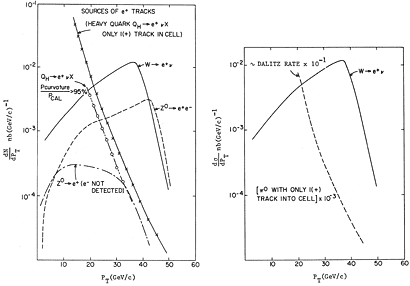
Figure 4: BNL W+→ e+ +X plots from Snowmass 1982 [30] with (left) expected heavy quark background (right) expected hadron backgrounds.
Back at my new office in 510, after Snowmass, before going to Paris, I calculated the formulas for the QCD parton-parton scattering predictions which I had spent the last few weeks studying and plotted them onto our π0-pair data-the agreement with q−q scattering was unbelievably beautiful once the running of αs(Q2) had been taken into account (Fig. 5).
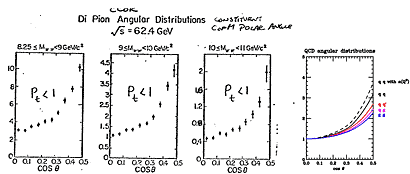
Figure 5: a) (left 3 panels) CCOR measurement [32,31] of polar angular distributions of π0 pairs with net pT < 1 GeV/c at mid-rapidity in p-p collisions with √s=62.4 GeV for 3 different values of ππ invariant mass Mππ. b) (rightmost panel) QCD predictions for the elastic scattering of gg, qg, qq′, qq, and qq with αs(Q2) evolution.
When I got to Paris, I bumped into Carlo Rubbia who was scheduled to present the conference highlights talk. I asked him to show my plot but he said something like: "Get lost, I have much better things to show". I was pretty disappointed and I went into the room where all the submitted contributions were on display and I met Knut Hansen (an ISR physicist from Neils Bohr Institute) who was organizing the Hard Hadron Physics parallel session. He said that CCOR had submitted a nice paper on π0-pairs [31], would I like to give a talk on it? [A third miracle, I guess.] Well it turned out that I gave my talk at the session at which UA2 had presented their famous lego plot of a jet, which convinced everybody that jets existed, so I got great exposure as evidenced by the fact that Carlo [who had been completely blindsided by the UA2 jet] came to me and asked for the plot to show in his talk as did Gunther Wolf who was the rapporteur on Jet Production and Fragmentation [32]. And, as they say, the rest of the story on jets and QCD is history...
One of the sidelights to Snowmass '82 was the contribution to the proceedings by Huson, Lederman and Schwitters [33] (not presented at the meeting) which claimed that one couldn't do an experiment at 1033 cm−2 sec−1 unless "the apparatus was shielded from the collision region by massive quantity of steel." This, in my opinion, was a blatant attempt to discredit the 800 GeV, 1033 cm−2 s−1 ISABELLE project compared to the proposed 2000 GeV 1030 cm−2 s−1 Tevatron [p]−p collider. As somebody who had been beaten to both the J/Ψ and the Υ by lower c.m. energy, much higher luminosity (fixed target) machines, I seemed to be the only person at BNL who strongly objected to this claim (in writing). Another thing that galled me was that Leon, who had originally proposed the 1033 cm−2 s−1 luminosity for ISABELLE 10 years earlier, now seemed to be saying that it wouldn't work. One good side of this debate (which I seem to have won in a classic example of a pyrrhic victory because the LHC is designed for 1034 cm2 s−1 with large open geometry detectors) is that the issue of pile-up became important and in a follow-up 1983 DPF workshop Randy Johnson [34] presented an elegant analytical solution for calculating pile-up right about the same time that we got α−α collisions in the ISR. This led me to write a CCOR internal memo (R-110:171) with the title, "How Leon Lederman drove me into convolutions and why this helped me to understand α−α collisions" as well as to much fun with Gamma and Negative Binomial distributions working with Chellis Chasman and John Olness in understanding A+A collisions at the AGS, and later at RHIC. One interesting point about my entry into heavy ion collisions with the α−α run at the ISR (proposed by Martin Faessler and others [35]) is that we were faced with either shutting off CCOR for a week and taking a short rest or running for that week and getting new physics and dozens of new papers. That's really no choice for a physicist-we ran the detector and took data; and exactly the same thing will happen at the LHC, so the funding agencies should plan for it.
Let me mention a few more issues with the W-boson before closing. For an SSC fixed target workshop in 1984 [39], I designed a 9.48 TeV coherently hardened photon beam for the purpose of using single W+ photoproduction, gamma+p→ W+ +n, to measure the tri-linear coupling gamma W+ W− coupling. The only good to come of this is that I realized that the existing calculations at that time had made the same mistake as in the original calculation of p+p→ d +W+: they left out the nucleon form factors. The calculations were corrected [40] but the measurement was done in e+ +e+→ W+ + W− at LEPII.
Then, in the early 1990's, for the RHIC Spin Collaboration, with the prodding of Aki Yokosawa and the help of Jacques Soffer [36], we figured out what we could learn about the proton spin structure by using the parity violating single spin asymmetry, AL, in W+ and W− production at RHIC. In fact, I made a presentation for the RSC at the PAC meeting of October 14, 1993 where I said that "with PHENIX, I can find W±→ e± +X in my sleep." I already knew this from the Snowmass '82 work, but in the intervening period, with Frank Paige [37] and others, we had done some more work on the acceptance and beautiful Jacobean peak in PHENIX [38] (Fig. 6) because the W at RHIC is essentially produced at rest.
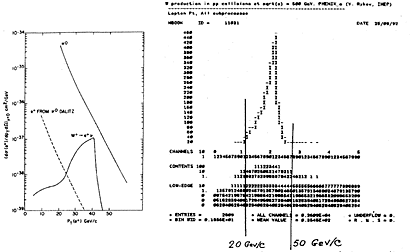
Figure 6: (Left) Predicted pT spectrum at √s=300 GeV from inclusive π0, background e+ from Dalitz decay of π0, and e+ from W+ decay [37]. (Right) Simulation of the inclusive e± Jacobean peak in PHENIX from 20,000 W±→ e± +X decays at √s=500 GeV[38]. The 2609 entries in the histogram give the 13% acceptance in this channel.
Also since UA2 had shown the method, practically in textbook form (Fig. 7) [41], which had agreed with our Snowmass plots, I knew that we had in the PHENIX central arms more than the minimum needed to find a clean sample of e± from W± decays: a factor of 1000 charged hadron rejection for pT > 10 GeV/c; precision EM Calorimetry out to 50 GeV; momentum resolution sufficient to resolve the charge of e± out to 50 GeV/c; a good trigger, as the W is only 10−8 of the total cross section.
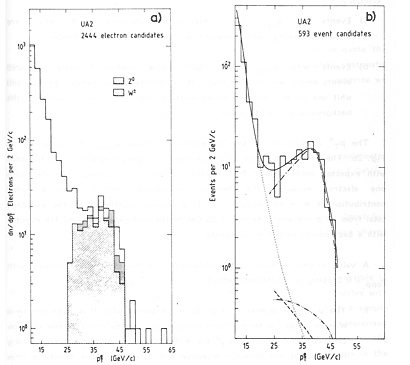
Figure 7: UA2 e± spectra a) without b) with "opposite azimuth" cuts [41].
For the final RHIC Spin Review in 1995, I made a plot of what precision to expect for the spin structure functions, ∆[q](x)/[q](x), ∆G(x)/G(x) etc., with the proposed integrated luminosity and the PHENIX detector then under construction (Fig. 8) [42].
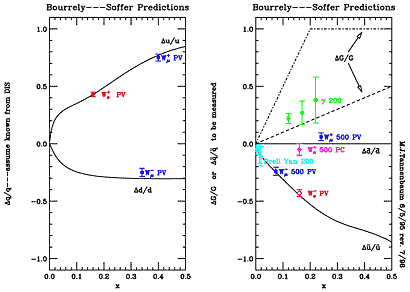
Figure 8: Expected sensitivities for spin-structure function measurements in PHENIX shown with Bourrely-Soffer distributions [36] for 800 pb−1 at √s=500 GeV and 320 pb−1 at √s=320 GeV.
All this happened so long ago that most of the younger people at RHIC seem to be unaware of this work and they keep rediscovering the same results using all the modern tools. For example, for the latest RHIC Spin Plan [43] and review of June 2008 (the n-th review, where n >> 1) Dave Kawall made this beautiful plot of W→ e +X in the PHENIX central arms, using RHICBOS, CETEQ5M and 6M structure functions, DSS fragmentation functions, etc. (Fig. 9).
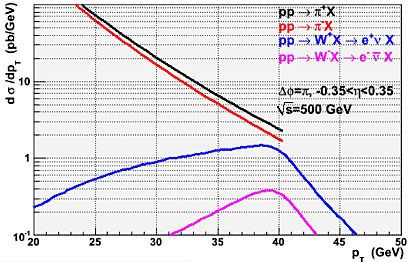
Figure 9: Latest opus of famous figure for the 2008 spin plan [43]. In agreement with previous calculations and measurements, a factor of ∼ 1000 reduction in pion background gives a clean W→ e+X signal for pT > ∼ 20 GeV/c.
It looks pretty much like all the previous plots, except that the Jacobean peak looks too wide to me. I would really like to see what will happen with the real data as I've been waiting 26 years since we made the original plot, which is now three years longer than the time between when the W was proposed and the time it was discovered. I get some consolation in the knowledge of how much physics was learned in the search for the W, which I tried to outline from a personal perspective in this article; but I remain troubled by the fact that we still don't understand why the muon mass is 206.77 times larger than that of the electron. [If you say it's the Higgs, please be kind enough to send me the formula which equals 206.77 when the numbers are plugged in.]
References
- [1]
- T. D. Lee and C. N. Yang, Phys. Rev. Lett. 4, 307-311 (1960), Phys. Rev. 119, 1410-1419 (1960).
- [2]
- M. Schwartz, Phys. Rev. Lett. 4, 307-307 (1960).
- [3]
- R. Cool, et al., Phys. Rev. Lett. 14, 724 (1965).
- [4]
- R. Cool, et al., Proc. 12th International Conference on High Energy Physics, Dubna, August 1964 (Atomizdat, Moscow, 1966) pp 852-856.
- [5]
- A. Zichichi, ibid., Vol 2, p 35.
- [6]
- C. Alff-Steinberger, et al., Phys. Lett. 20, 207 (1966).
- [7]
- F. J. M. Farley, et al., Nuovo Cimento 44, 281 (1966).
- [8]
- L. M. Lederman and M. J. Tannenbaum, Advances in Particle Physics, Volume 1, p. 1, Eds. R. L. Cool and R. E. Marshak, (Interscience, New York, 1968).
- [9]
- B. Adeva, et al. (SMC), Nucl. Instrum. Methods A343, 363 (1994).
- [10]
- S. J. Brodsky and S. C. C. Ting, Phys. Rev. 145, 1018 (1966).
- [11]
- Michael J. Tannenbaum, Phys. Rev. 167, 1308 (1968).
- [12]
- C. T. Munger, S. J. Brodsky and I. Schmidt, Phys. Rev. D49, 3228 (1994).
- [13]
- Proc. Workshop, "Can RHIC be used to test QED?", Upton, NY, April 20-21, 1990, Eds. M. Fatyga, M. J. Rhoades-Brown, M. J. Tannenbaum, BNL-52247 (1990).
- [14]
- J. J. Russell, et al., Phys. Rev. Lett. 26, 46 (1971).
- [15]
- W. K. H. Panofsky, Proc. 14th International Conference on High Energy Physics, Vienna, 1968, (CERN, Geneva, 1968) pp 23-39.
- [16]
- Robert P. Crease, Phys. Perspect. 7, 330-376,404-452 (2005)
- [17]
- M. May, et al., Phys. Rev. Lett. 35, 407 (1975).
- [18]
- H. Gittleson, et al., Phys. Rev. D10, 1379 (1974).
- [19]
- M. Murtagh, et al., Phys. Rev. D10, 3873 (1974).
- [20]
- S. M. Berman, J. D. Bjorken and J. B. Kogut, Phys. Rev. D4, 3388 (1971).
- [21]
- See figure by F. W. Büsser, et al. (CCR), Proc. 16th International Conference on High Energy Physics, Eds J. D. Jackson and A. Roberts, (NAL, Batavia, IL, 1972), Vol 3, p. 317.
- [22]
- F. W. Büsser, et al. (CCRS), Nucl. Phys. B113, 189 (1976).
- [23]
- A. L. S. Angelis, et al. (CCOR), Phys. Lett. B94, 106 (1980); see also, M. Diakonou, et al. (ABC-R806), Phys. Lett. B87, 292 (1979).
- [24]
- e.g. see M. J. Tannenbaum, Nucl. Phys. A749, 219c (2005).
- [25]
- e.g. see M. J. Tannenbaum, Heavy Ion Phys. 4, 139 (1996).
- [26]
- Proc. 1982 DPF Summer Study on Elementary Particle Physics and Future Facilities, Snowmass, CO, June 28-July 16, 1982, Eds. R. Donaldson, R. Gustafson, F. Paige (Fermilab, Batavia, 1983).
- [27]
- M. J. Tannenbaum, pp 184-193 in Ref. [26].
- [28]
- e.g. see M. J. Tannenbaum, Int. J. Mod. Phys. A4, 3377-3476 (1989).
- [29]
- M. J. Tannenbaum, Proc. 1980 Int. Symposium on High Energy Physics with Polarized Beams and Polarized Targets, Lausanne, Sept. 25-Oct. 1, 1980, Eds. C. Joseph and J. Soffer (Birkhauser Verlag, Basel, 1981) pp 379-388.
- [30]
- G. Bunce, et al., pp 489-499 in Ref. [26].
- [31]
- A. L. S. Angelis, et al., Nucl. Phys. B209, 284 (1982).
- [32]
- M. J. Tannenbaum, Proc. 21st Int'l Conf. HEP, Paris, 1982, Eds. P. Petiau, M. Porneuf, J. Phys. C3 (1982) p. C3-134; see also G. Wolf, ibid. p. C3-525.
- [33]
- pp 361-368 in Ref. [26].
- [34]
- R. Johnson, Proc. 1983 DPF Workshop on Collider Detectors: Present Capabilities and Future Possibilities, Berkeley, CA, Feb. 28-Mar 4, 1983, Eds. S. C. Loken and P. Nemethy (LBL-15973) pp 122-124.
- [35]
- M. A. Faessler, Phys. Repts. 115, 1-91 (1984); also, see CERN/ISRC/79-3, 79-10, 80-6.
- [36]
- C. Bourrely and J. Soffer, Phys. Lett. B314, 132 (1993), Nucl. Phys. B445, 341 (1995).
- [37]
- F. E. Paige and M. J. Tannenbaum, BNL-33119 (1983); and F. E. Paige, private communication (see M. J. Tannenbaum, Omega Group Internal Report OG769, November 1983).
- [38]
- A. A. Derevshikov and V. L. Rykov, RSC-BNL/IHEP-4, August 1992 (unpublished).
- [39]
- M. J. Tannenbaum, (BNL-34614), Proc. SSC Fixed Target Workshop, the Woodlands, TX, Jan 27-29, 1984, Ed. P. McIntyre (TAMU, College Station, 1984), pp 56-61.
- [40]
- D. A. Dicus and K. J. Kallianpur, Phys. Rev. D34, 3533 (1986).
- [41]
- J. A. Appel, et al. (UA2), ZPC30, 1-22 (1986).
- [42]
- M. J. Tannenbaum, Proc. Adriatico Research Conference on Trends in Collider Spin Physics, ICTP, Trieste, Italy, Dec. 5-8, 1995, Eds. Y. Onel, N. Paver, A. Penzo (World Scientific, Singapore, 1997) pp 31-53.
- [43]
- G. Bunce, et al., "Plans for the RHIC Spin Physics Program", June 9, 2008.

